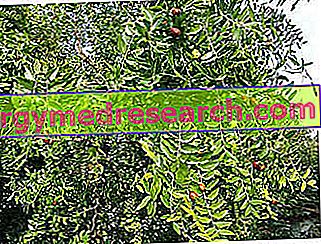What is Gragnano Pasta
Gragnano pasta is a pasta made of durum wheat semolina, produced in the Neapolitan municipality of the same name. For several years now, the quality of this pasta has been confirmed by the awards: PAT (Traditional Agri-food Product) and IGP (Protected Geographical Indication).

Gragnano pasta is ideal for lightly aqueous sauces, such as tomato sauce or others that contain it (amatriciana, norma, arrabbiata etc.).
The term Gragnano paste refers to different types of pasta. Among these, some are classic, such as spaghetti, fusilli, maccheroni, paccheri, etc .; others are less known, such as the calamarata, the caccavella, the sun of Capri and the stars.
From a nutritional point of view, Gragnano pasta is classified in the III fundamental group of foods, as a significant source of complex carbohydrates (energy function) and fibers. Although not in large quantities, it contains various vitamins and mineral salts.
Nutritional properties
Nutritional characteristics of Gragnano pasta
Gragnano pasta is a product that belongs to the III fundamental group of foods. Raw, it has a high energy intake and a low concentration of water; after cooking the percentage of hydration doubles and the energy content is halved.
Calories are supplied mainly by complex carbohydrates, followed by a modest amount of protein and lipid traces.
Carbohydrates have a prevalence of complex molecules (starch) and peptides have a medium biological value. The fiber intake is good but not excellent, while cholesterol is absent.
Gragnano pasta contains gluten and the only potentially allergenic molecules are wheat proteins.
From the vitaminic point of view, there are significant quantities of some water-soluble of group B, such as thiamine and niacin (B1 and PP). As far as mineral salts are concerned, potassium, phosphorus, iron and magnesium levels are appreciable.
Gragnano pasta is suitable for any diet, even if it requires an adjustment of the portion in case of overweight, type 2 diabetes mellitus and hypertriglyceridemia.
Containing gluten, it is totally excluded from the celiac diet. It respects vegetarian and vegan criteria and has no contraindications for religious diets.
The average portion of Gragnano pasta is 80 g dry (about 280 kcal).
| Power | 353.0 kcal | |
Protein | 10.9 g | |
Lipids TOT | 1.4 g | |
Saturated | 0.22 g | |
Monounsaturated | 0.16 g | |
polyunsaturated | 0.69 g | |
Cholesterol | 0.0 mg | |
Carbohydrates | 79.1 g | |
Simple | 4.2 g | |
Sodium | 4.0 mg | |
Potassium | 192.0 mg | |
Football | 22.0 mg | |
Phosphorus | 189.0 mg | |
Iron | 1.4 mg | |
Magnesium | 51.0 mg | |
Thiamine | 0.1 mg | |
Riboflavin | 0.2 mg | |
Niacin | 2.5 mg | |
Vitamin A | 0.0 µg | |
C vitamin | 0.0 mg | |
Vitamin E | 0.0 mg | |
use
Uses of Gragnano pasta
Gragnano pasta is used in the kitchen in the same way as any other dry semolina pasta.
Optimal cooking
It requires cooking in boiling water, for a variable time depending on the format (usually around 8-13 '). To cook it in an optimal way it is necessary that the temperature is about 100 ° C and not drastically drops when it is immersed. Therefore, it is essential that the heat source is sufficiently intense and that the ratio between the weight of the pasta and the volume of water is 1/10.
At the most critical moment, when you throw the food away, you can immediately cover the pan with a lid to help maintain or resume boiling, remembering to mix it almost immediately to prevent sticking (in the case of spaghetti, paying attention to do not break them).
There are at least 3 levels of pasta cooking: very al dente, al dente and cooked. These should not be estimated only by checking the time spent in the boiling water, but they must take into account any additional steps such as "stir-fry" (to tie the sauce and make it adhere to the dough).
There is also an alternative cooking technique, used both for long and short pasta, commonly called " risottatura ". It consists of cooking pasta, totally or mainly, directly in the cooking sauce (see, for example, our recipe for pasta with tomato risotto). The most suitable format is thin spaghetti.
We recall that the salting level of pasta-based recipes depends on 4 factors: quantity of salt (coarse) added to the boiling water (estimated on the weight / salt ratio, about 1/10), flavor of the ingredients in the sauce, amount of salt added in it and flavor of any cheese to be added at the end.
Recipes
Gragnano pasta is ideal for making first courses: sautéed, in broth and au gratin. There is no more indicative recipe than the others, even if, respecting the Neapolitan origins, it is necessary to mention: pasta with tomato and basil, pasta omelette and spaghetti with Neapolitan ragù.
Production
Introduction to the production of Gragnano pasta
The production of dry pasta is not complicated. It consists of forming a dough based on flour (semolina) and water, which will then be preformed and dried. On the other hand, Gragnano pasta has a very high quality level and enjoys two acknowledgments: Traditional Agri-food Product and Protected Geographical Indication. Furthermore, the assignment of the IGT requires producers to use exclusively Italian durum wheat flour ( Triticum durum ) and local spring water, to use bronze drawing machines and to apply a drying that can last (to depending on the shape of the pasta) up to 60 hours.
History
A brief history of Gragnano pasta
Gragnano pasta has its roots in the Valle dei Mulini, where for centuries local millers have transformed local wheat into flour.
Using spring water for the dough and taking advantage of the local microclimate for drying, in the sixteenth century the Gragnano people founded the first pasta factories. After a while the advent of the first technologies arrived, as evidenced by a register of 1596 which shows the payment of some mechanical components for the production of pasta.
Until the seventeenth century, dried pasta was considered a low consumption product and, only after the famine in the Kingdom of Naples, became a true local icon.
The association between the Neapolitans and fresh pasta became such as to transform their previous nickname of "receipt of leaves" into "mangiamaccheroni". Written evidence demonstrates that the production of Gragnano pasta reached its peak in the nineteenth century, when large companies made their appearance, gathered mainly along Via Roma and Piazza Trivione, thus expanding the town's urban center. Just before the unification of Italy, Gragnano boasted about a hundred pasta producers, who offered work to about 70% of the local population; some of those companies are still in business.



